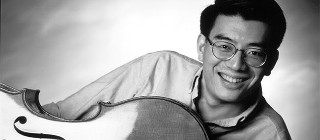|
Back
Honoring Timothy Landauer (1963-2019) Orange County
Renée and Henry Segerstrom Concert Hall
05/16/2019 - & May 17, 18, 2019
Sir Edward Elgar: Enigma Variations, opus 36: Variation IX (Adagio) “Nimrod”
Frank Ticheli: Rest
Maurice Ravel: L’Enfant et les sortilèges, M.71
L’Enfant et les sortilèges: Tess Altiveros (The Child), Nicole Birkland (Mama, The China Cup, The Dragon Fly), Patricia Westley (The Louis XV Chair, A County Lass, The Bat, The Screech Owl), Liv Redpath (The Fire, The Princess, The Nightingale), Leandra Ramm (A Shepherd, The White Cat, The Squirrel), Benjamin Sieverding (The Armchair, A Tree), Hadleigh Adams (The Black Cat, The Grandfather Clock), Brian Wallin (The Teapot, The Little Old Man, The Frog)
Pacific Chorale, California State University, Fullerton Singers, Robert Istad (artistic director), Southern California Children’s Chorus, Lori Loftus (chorus master), Pacific Symphony, Dennis Kim (concertmaster), Carl St. Clair (conductor)
Robert Neu (director), Matt Scarpino, Hannah Welter, Kristin Campbell (scenic designers), Alethia R. Moore-Del Monaco (costume designer), Kathy Pryzgoda (lighting designer) 
T. Landauer (© Pacific Symphony)
If anyone has frequented Pacific Symphony with any regularity, then likely one has witnessed the extraordinary talents of former Principal Cellist, Timothy Landauer. The first half of a double-billing, originally slated to feature Prokofiev’s Peter and the Wolf, was preempted due to the sad news of Pacific Symphony’s loss of the esteemed cellist on April 24. The opening piece, “Nimrod” from the Enigma Variations, gave a fitting musical preamble to the young man’s 27 year career with a stately trim of dignified passion. If the sorrow could be doubly fortified, Carl St. Clair chose to re-engage Frank Ticheli’s Rest for Chorus and Strings since the piece was originally written for the maestro’s loss of his own son, Cole, back in 1999. M. Ticheli’s composition was an open embrace of benevolent softness, sheer in might and immensely broad in vocal polish, delivered by the Pacific Chorale and California State University Fullerton Singers under the direction of Robert Istad...the permeation was irrefutable.
The evening’s acme, however, arose during the video clip of Timothy Landauer performing Richard Strauss’ final variation (XI), “The Death of Don Quixote” (barring the last conclusive 30 seconds) from his tone poem, Don Quixote. This presentation gave a dynamic grasp of the cellist’s character though his eyes, his face, his hands and his heart. Incredibly moving was the camera’s focus on M. Landauer’s engrained strength of vibrato vibrantly running through his fingers and onto the fingerboard. He had an unstoppable determination to strive for the best and extract the most. His journey for superb conditioning never fell short, and as audience members, it gave us all a moment to live in the world he loved and where he felt most comfortable.
Superficially, Maurice Ravel’s L’Enfant et les sortilèges is a heady vision of musical revue pastiche, though the underlying sobriety remains intact. Over the past several years Pacific Symphony has brought opera to the concert stage, including Verdi’s successful Aida in 2017. Though not new to opera, Robert Neu, admittedly, was unfamiliar with the Basque composer’s fantaisie lyrique, but that didn’t stop him from attempting to make a memorable impression. Highly skilled and poised with theatrical charisma, Neu’s L’Enfant et les sortilèges’ overall carriage was ‘overwrought of excesses, in an unseemly competition of disciplines vying for attention.’ Ravel’s train was derailed.
The biggest conundrum rested upon Maestro St. Clair, whereby the orchestra’s fortissimo clauses frequently and annoyingly drowned out singers while disrupting acoustical clarity. On the other hand, the production’s strength landed in the laps of those individual singers whose vocal lines were encased inside Ravel’s piano pockets. L’Enfant et les sortilèges’ best cast member was Liv Redpath and her coloratura which had a swiftness of ease and a plucking of pin pricking detail inside her three rôles as The Fire, The Princess and The Nightingale. Specifically, Mlle Redpath had a lovely spot alongside Benjamin Smolen’s flute solo. Hadleigh Adams’ broad baritone extensions added great weight to his Black Cat and the Grandfather Clock while Brian Wallin made good use of his amusing narrative ditty as he foxtrotted away as The Teapot alongside Nicole Birkland’s The China Cup. Tess Altiveros made sufficient strides in eliciting the bratty child, although she, too, was overwhelmed by the orchestra.
Some of the characters’ dilution was reinforced by Alethia R. Moore-Del Monaco’s garish mish-mash costuming while simultaneously being aggravated by the elementary two-dimensional cardboard cut outs by les trois. Kathy Pryzgoda’s lighting tried ‘less hard’, suggesting an appropriate tone during the transitional movement to the outdoors, but the arithmetic mayhem consumed, overwhelmed and annoyingly flooded the stage; Robert Neu seemed to have lost his grip on group numbers (i.e. painted wallpaper, “the finale”), and no imaginative choreography was to be found.
Undoubtedly, Timothy Landauer’s tribute eclipsed L’Enfant et les sortilèges and with just reason. The impact was monumental. In the words of Carl St. Clair, “we felt his soul...we heard his heart...he made a lasting imprint.” The principal cellist’s chair may be empty, but Timothy Landauer’s musical outpourings will retain permanent occupancy.
Christie Grimstad
|